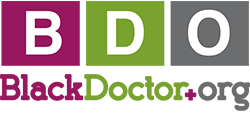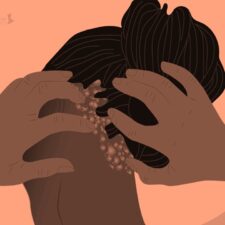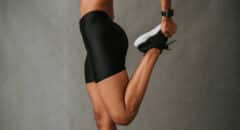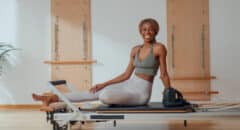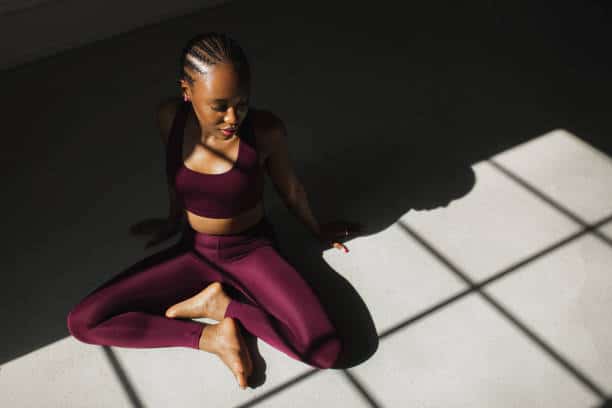
When done right, crunches can strengthen the lower back while reducing pain. They can also improve your flexibility and posture. That doesn’t mean you have to like them, though. Despite being touted as being convenient, low-impact, and low-stress on the back, some people don’t like doing crunches. They generally force themselves to do a few to get the benefits while hating every second of it. If that’s you, the good news is that you don’t have to make yourself do crunches. Pilates has some great exercises that have all the benefits of crunches and even more.
10 Pilates Exercises That Put Crunches to Shame
1. Pilates Hundreds
- Lying on the ground, reach your legs up to a 45-degree angle (or closer to 90 degrees if your lower back is sensitive).
- Curl up using your abs and lift your head, neck and chest off of the ground.
- Reach your arms along your sides with the palms facing down.
- Inhale for five counts as you pump your arms up and down, and then exhale for five counts as you keep pumping your arms.
- Repeat for a total of 100 pumps.
2. Pilates Toe Taps
- Lie on your back with your knees bent and feet parallel and hip-width apart.
- Exhale and take one leg into tabletop (same as the exercise above).
- Inhale to hold the position.
- Exhale to lift the second leg into tabletop, without popping your abdominals or arching your back.
- Inhale the position.
- Exhale with control, and touch one foot to the floor, keeping your other leg stable.
- Inhale your leg back to the tabletop.
- Repeat with the opposite leg.
RELATED: Is Wall Pilates Worth It? 10 Beginner Exercises to Help You Find Out
3. Single-leg Stretch
- Lie on your back with both legs on the tabletop.
- Exhale to curl your head, neck, and shoulders off the floor so you’re looking at your knees. Inhale to put your hands on the sides of your knees.
- Exhale to stretch one leg out at a 45-degree angle or lower, only as low as you can while keeping your back and pelvis in the same position. Avoid arching your back, and watch for the abdominals doming. The hand on the side of the stretched leg will reach toward the opposite ankle.
- Inhale to bend your knee back to the 90-degree position.
- Repeat with the opposite leg.

4. Leg Lifts
- Lie on your back with your knees bent and feet parallel and hip-width apart.
- Inhale to breathe into the back of your ribs.
- Exhale to draw your pelvic floor and abdominals up and in. Imagine you’re gently tightening a belt, and lift one leg up into the tabletop without moving your hips, pelvis, or back.
- Inhale to hold the position.
- Exhale to lift the second leg into tabletop, without popping your abdominals or arching your back.
- Breathe and hold the position for 5 counts.
- Exhale with control to return your feet to the floor.
5. Double-leg Extensions
- Begin lying on your back with your knees bent and drawn toward your chest.
- Lie on your back with your knees bent and pulled toward your chest, head, neck, and shoulders lifted off the mat.
- Hold your ankles with your hands, then extend both arms overhead and both legs straight out toward the mat. Keep the arms and legs a few inches off the floor to ensure full engagement of your core.
- Circle your arms outward and around while bringing your knees back toward your chest, and repeat the movement, engaging your core to maintain control.
- Be mindful of keeping your lower back pressed into the mat, preventing any arching or strain.
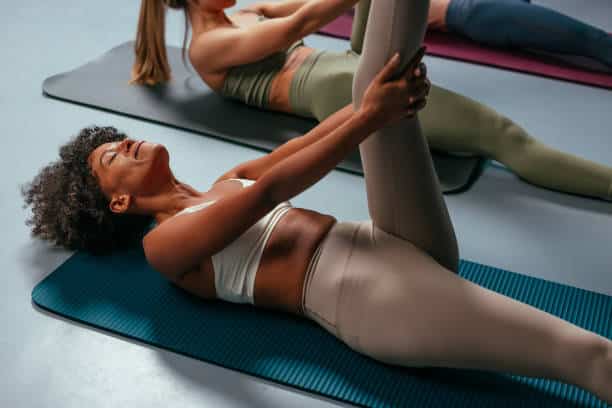
6. One Leg Circle
- Lie on your back with both legs straight on the floor. Try to maintain a neutral pelvis.
- Exhale to lift one leg up in the air (your knee can be slightly bent).
- Keep your hips still and inhale to reach the leg in the air across your body.
- Exhale to make a circle with your leg, trying not to let your pelvis rock with its movement.
- Repeat 5 times in each direction and switch legs.
7. Full Roll Up
- Sit with your knees bent and feet flat on the floor.
- Grab your shins with your hands and lift both of your feet off the ground.
- Hug your knees into your chest, keeping your thighs together.
- Round your back slightly while pulling your abs in.
- Roll back onto your shoulder blades. Then, engage your core to roll back up to the starting position.
- Repeat for 10 reps.
8. Sidekick
- Lie on your side with your bottom arm reaching long overhead, and rest your ear on your arm. Keep your knees straight and bring your feet forward, angling your legs about 30–45 degrees in front of your body.
- Imagine you’re gently tightening a belt to lift and draw in your abdominals.
- Lift your top leg up until it’s in line with your hip.
- Without arching or flexing your back, inhale to kick your leg forward.
- Exhale to kick your leg back, opening your hip and engaging your glutes and hamstrings.
- As you bring your leg through the full range of motion, aim to keep your hips stacked and spine long, without arching, tucking, or rolling your pelvis out of position.
- Repeat 8–10 times and switch sides.
9. Swan Dive
- Keeping your elbows parallel and bent, lie face down on the floor with your hands flat on the floor and in line with your shoulders.
- Begin with your body engaged, your abs drawn in and up, and your lower back lengthened (be sure not to sink or arch into your lower back). Your legs are straight and lengthened, with your hamstrings and glutes engaged.
- Inhale to imagine reaching through the top of your head. Gently press into the floor with your hands and lift your head, chest, and ribs as far as your body will go without strain.
- Exhale to lengthen your torso and return to the mat.
- Repeat 5–8 times
10. Plank
- Start on your forearms and knees.
- Exhale to draw the abs inward and upward, taking one leg back to a straight position and then the other.
- Hold for 30–60 seconds.
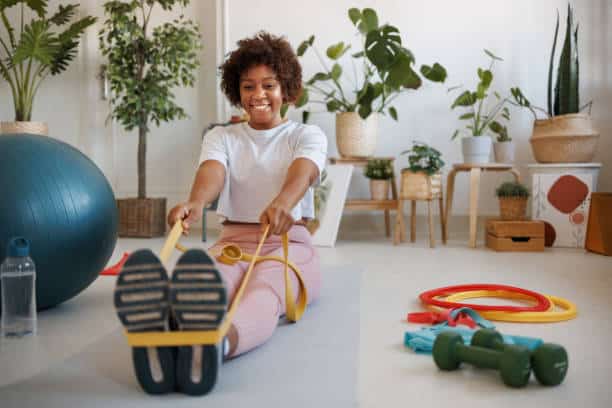
RELATED: Pilates for Black Girls: A 30-Day Routine to Strengthen and Tone Your Body
How Pilates Boosts Your Health
When you do the exercises listed above, you’ll not only work on your midsection but also the deep core muscles and the pelvic floor. Over time, you’ll strengthen your core muscles that prevent injuries to the spine. You can also improve your balance and stability. Those benefits become especially handy for those who are older, as it prevents falls.
While you may enjoy seeing a more toned stomach, the benefits go deeper than that. Athletic experts say that your core links your upper and lower body. When you have a strong core, it improves your overall performance and endurance. That can be helpful whether or not you’re working to upgrade your existing skills or try something new.
Pilates, in general, also helps with your functional strength. Your level of functional strength is determined by the ease with which you can do everyday activities like maintaining good posture, lifting objects, walking in a balanced way, and getting out of bed. Not being able to carry out these tasks without pain is usually a sign that your functional strength isn’t where it should be.
Finally, doing Pilates can reduce your likelihood of depressive episodes, help you manage your stress levels, boost your energy, improve the quality and quantity of your sleep, improve your brain function, and improve your immune system.
Crunches can be great to tone your midsection, but they’re not your only option. You can get all the benefits of doing crunches and more by doing a few Pilates exercises instead. If you have any concerns about trying it for the first time, talk to your doctor.
